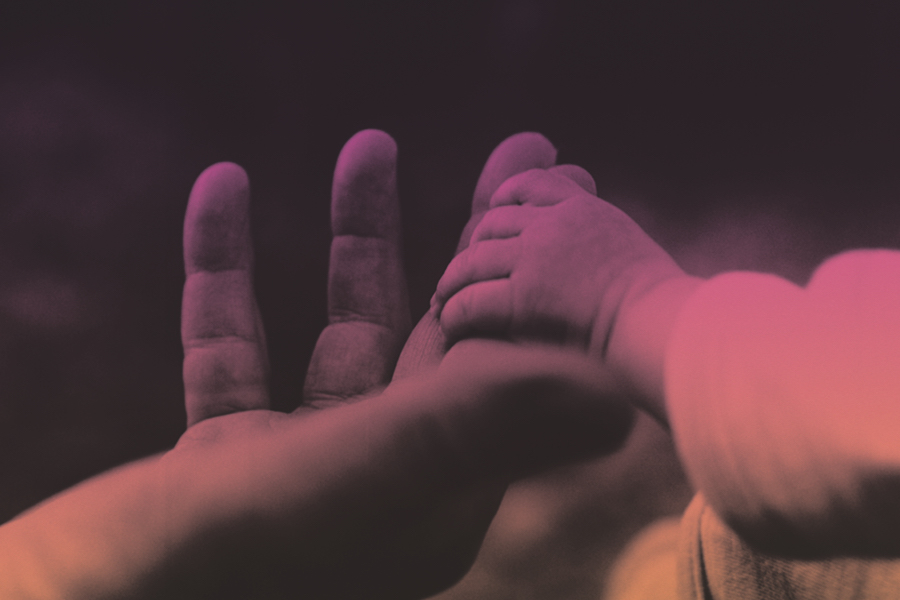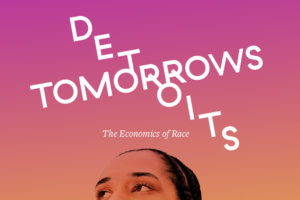Darrick Hamilton calls for spreading the benefits of asset-ownership to all Americans.
JOIN THE INSTITUTE IN DETROIT FOR A CONFERENCE ON RACE & ECONOMICS, NOV. 11-12.
Imagine that a black child from a family of modest resources gets the opportunity to attend an elite college preparatory school. Motivated by a love of learning and strong desire to achieve, he excels in school and goes on to attend highly regarded universities, earning advanced degrees. Surely that child is well positioned to ascend the ladder of economic prosperity in America, right?
Not so fast.
The goal of broadening financial wealth to all Americans, regardless of race, gets plenty of applause across the political spectrum. But so far this goal has remained devilishly elusive. To understand why you have to know how people come by wealth in the first place. It’s popular to say that we build wealth through discipline — by hitting the books, working hard and saving money. The reality is a little different.
Past injustice shapes present reality
Darrick Hamilton knows this from personal experience. Despite his family’s modest means — not poor but hardly affluent — he attended the Brooklyn Friends School, an elite private institution where teachers emphasized social justice. Hamilton started college at Oberlin excited to seek out his path to the American Dream. But he soon found out that the path was smoother for some than for others.
All around him, white kids from affluent families were getting checks in the mail from their parents — money that could be spent on tuition, extracurricular activities, and the kind of socializing that builds professional networks. Black students of more modest means, on the other hand, were often at a disadvantage even when their parents were able to help financially. If they received money from home, things besides books demanded financial attention. The same was true if they had a job. Even when black students worked hard and saved diligently, the money was often spoken for before it was time to pay the tuition bill for the semester.
The reason has to do with the cumulative effects of centuries of gross economic disadvantages that black families have endured, from slavery to Jim Crow and beyond. The legacy of those severe headwinds is that even when an individual family is able to reach the middle class, there is still likely to be a constellation of poorer extended family members in need of various kinds of financial assistance. When they call, you help, if you can. Economists call this “wealth leakage.”
Hamilton noticed this phenomenon play out among black students at school and in the professional realm. Rather than enjoying resources from parents and grandparents, they often had to provide money for cousins, nieces, uncles, and siblings. After obtaining his Ph.D. in economics at UNC-Chapel Hill, Hamilton, who now teaches economics and urban policy at The New School in New York, focused on how poverty in the family increases the racial wealth gap for middle class black individuals.
The source of wealth building in America, he realized, is less what you save than your capacity to invest in an asset through money given by parents and grandparents. These transfers are critical to the acquisition of assets, like a home or a small business — the kinds of things that require huge down payments.
“If you’re not fortunate enough to get that down payment or have that resource at a key juncture of your life,” observes Hamilton, “you will not have that pathway towards building economic security that somebody else has. You could be a jerk. You could be a good person. It has little to do with the particular individual.”
This logic flies in the face of the long-cherished belief that education and hard work are the great equalizers in American society. Many still insist that much present day inequality is caused by bad individual decisions and not by structural problems associated with discrimination. But the vast inequality between black and white citizens suggests that there’s more going on than poor choices. In 2013, according to the Federal Reserve’s Survey of Consumer Finances, the median household wealth was $134,230 for whites compared to a paltry $11,030 for black Americans.
The reason, says Hamilton, is pretty clear: “In a capitalist system, if you lack capital, it just locks in inequality.”
Fortunately, he thinks the problem can be alleviated if we are willing to aim the attack at the source. Hamilton and his colleague William A. Darity, Jr. of Duke University are stratification economists, pioneers in an emerging subfield of social science who focus on the structural dimensions of a person’s economic position. They propose a solution to wealth inequality that may appeal across the political spectrum: Why not give every American baby seed capital so they can grow up to take part in the capitalist system? This could be done, they argue, through “Baby Bonds” that would be set up for every child born.
How Baby Bonds work
Baby Bonds, in Hamilton’s formulation, would be funded directly out of Treasury and held in an account by the federal government, similar to Social Security. The amount a child receives would depend on the wealth position into which she is born. If she’s the offspring of Oprah Winfrey and Bill Gates, she might get $500, but upwards of $50,000 if she is born at the lowest rungs of the economic ladder. The average amount for a child would be around $20,000. Accounts would be guaranteed a nominal one and a half rate of return, and the payout would not take place until the child becomes an adult. At that time, you get to spend the money — but not just on anything. The funds would have to be used for a “clearly defined asset enhancing activity,” like financing a debt-free education, purchasing a business, or buying a home. (The program would need to be coupled with financial reform and regulation to mitigate predatory effects, including extraordinary tuition increases aimed at exploiting better-resourced young adult baby bond recipients).
A commission would be set up to identify exactly what kinds of activities might qualify.
“These conditions are set up to protect the resource,” says Hamilton. “In my own situation, if I had received an infusion of cash as a young adult, there would have been a lot of family needs to take care of before I could begin thinking about self-investment like purchasing a home. Specifying what the money can be spent on may not guarantee an outcome, because people still choose the investment they engage in, but it at least ensures that the investment is an asset-enhancing endeavor which can help build wealth over the long run.”
Unlike some past proposals for child savings accounts, Baby Bonds are designed so that it doesn’t matter if your parents can contribute or not. Hamilton says this is done so that however good or bad or affluent or poor your parents may be, as a citizen you get some seed capital so that you can take part in the American economic mobility system.
But wouldn’t such a program be too costly?
Not at all, says Hamilton. He notes that there are about 4 million children born every year, so if the average account is at $20,000, the whole program might cost $80 billion. If you add another $10 billion, the very highest estimate for administering the program, it comes to $90 billion maximum. That might sound like a lot, but not when you consider what the federal government already spends trying to promote asset ownership through the tax code. He cites a report on all such policies (like the mortgage interest reduction and reductions in capital gains) by CFED, a Washington-based non-profit focused on expanding economic opportunities for low-to-moderate income Americans. All told, these programs cost over $500 billion dollars. (The mortgage interest deduction alone is estimated to cost more than $405 billion for tax years 2014 through 2018).
Next to these figures, Baby Bonds looks like a bargain. They also have the advantage of distributing the capital where it’s needed most. Federal programs already in place tend to funnel money towards the more affluent, says Hamilton, noting that the bottom 60 percent of earners get about 5 percent of that $500 billion, while the top 10 percent get well over half. He thinks that Baby Bonds could be fully funded simply by capping the existing mortgage interest reductions.
So how would a race-blind program help to close gaps in wealth and income between black and white Americans?
Hamilton points out that about 85 percent of black households fall below the national median of the wealth distribution, so the means test for the Baby Bonds program as well as its target needs to be keenly focused on wealth.
Baby Bonds address wealth in two ways: First, because of the way black people are clustered at the poorer end of the wealth distribution, more will qualify for the program. Secondly, because the program is focused on asset-enhancing activities, they will benefit when they become adults and are able to use the funds to build the kinds of assets that have so often been out of reach historically.
A potential political winner?
Inequality has been a hot topic this political season, but much of the discussion has focused on student debt. Hamilton acknowledges that this is important, but it’s not enough to close the racial wealth gap.
“It will help avoid wealth leakage for millions of people and black individuals that end up going to college,” he says. “It’s certainly the case that black students are disproportionately impacted by student debt. But this only helps those who actually end up going to college. It’s limited in its approach.”
Something more is needed. He notes that in other countries, programs similar to Baby Bonds have already been implemented, such as a child trust program set up in 2005 that gave every British citizen born on or after September 1, 2002 an investment account to build savings that would help fund their transition to adult life.
The U.K. program differed from Baby Bonds in several key ways: it was smaller in scale, parents could add to the account, and the trust was unconditional, meaning that the money could be used for anything rather than a specific set of potentially wealth-building activities. Unfortunately, the program sank under a wave of austerity in 2011 following the global recession, so it’s unclear exactly how well it worked because the children who received the accounts are not yet old enough to have used them.
Could Baby Bonds work in America? Hamilton observes that in the past, both conservatives and liberals have endorsed programs designed to give American children a stake in the future. KidSave, a program conceived by then-Senators Bob Kerrey of Nebraska, with then-Senator Joe Lieberman of Connecticut as co-sponsor, would have allotted each child a small deposit at birth (around $1000), with additional $500 deposits every year for five years. The money would then be invested in a limited number of mutual funds, but it couldn’t be withdrawn until retirement, when a substantial nest egg would have theoretically grown. Various versions of the plan attracted support from conservatives like Senator Rick Santorum of Pennsylvania and the Heritage Foundation.
The premise behind Baby Bonds is slightly different; it’s based on the recognition that the problem in building wealth is not savings.
“Most Americans don’t save, period,” says Hamilton. “It’s really getting access to that asset that’s going to appreciate. Homes give Americans most of their wealth, or, if not homes, some other asset. So this is moving us a bit from that narrative of how to leverage poor people to do better things by giving them incentives to saying, well, why don’t we empower them with an account so that they actually can make decisions that can lead to their mobility.”
Hamilton observes that Baby Bonds simply arm everybody with the opportunity to benefit from the markets— an idea the most die-hard free market champion might appreciate. “If conservatives really believe in the fairness of the markets,” he says, “then let’s give everybody opportunity to participate. We’re talking about babies, so this is before we start coming up with narratives about the deserving poor or the undeserving poor. We’re saying, at birth, we’re going to give everybody a chance to engage in economic mobility in America.”







